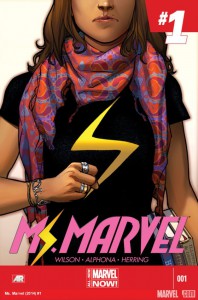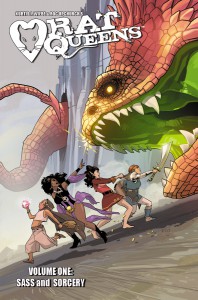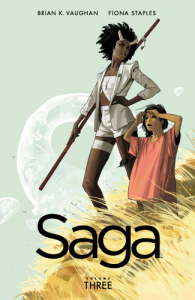written by David Steffen
The final category I’m reviewing in the Hugo Award review series for this year, this is for the graphic story category. Â I like graphic stories, but I tend to not do a very good job keeping up with them, so I use this category as a chance to get a sampling from some popular stories.
Also on the ballot in this category is Paper Girls Volume 1 by Image, which I simply didn’t find the time to read.
 1. The Vision, Volume 1: Little Worse Than A Man, written by Tom King, illustrated by Gabriel Hernandez Walta (Marvel)
1. The Vision, Volume 1: Little Worse Than A Man, written by Tom King, illustrated by Gabriel Hernandez Walta (Marvel)
The Vision is a synthezoid, a sort of android that is constructed of human flesh and human memories, created by Ultron but ultimately turning on his creator and eventually joining the Avengers team. Â He has various powers, including the ability to control his own body density to either phase through objects or become a dense weapon, he also has a laser in his forehead, and the computing capacity of a machine. Â Before the start of this comic, in a manner which is never really explained as far as I could tell in this comic, the Vision has died and resurrected, and in the aftermath of trying to work through his own death he has created several offshoots of himself to act as a wife, a son, and a daughter, and the four of them have moved into a house in the suburbs. Â Vision is trying to understand what it is to be human by filling the role here, (while simultaneously acting as a member of the Avengers).
I loved this comic, had a lot of the sort of appeal that Spock or Data have in analyzing what makes humans human, but with an extra unpredictable element–Vision’s various selves are not always mentally stable, especially under the stress of trying to fit in to suburban life where they are obviously different. Â This comic has a lot of interesting things to say about the human condition, while being both very dark at times and very funny, particularly when the Vision is mansplaining how to be human to Virginia who generally comes across as more human than he is. Â I rarely keep up with ongoing comics, but I’d like to keep up with this one.
 2. Ms. Marvel, Volume 5: Super Famous, written by G. Willow Wilson, illustrated by Takeshi Miyazawa (Marvel)
2. Ms. Marvel, Volume 5: Super Famous, written by G. Willow Wilson, illustrated by Takeshi Miyazawa (Marvel)
Kamala Khan/Ms. Marvel is struggling to keep up with school, family, and being a member of the Avengers team all simultaneously. Â She wants it all, and she’s sure she can manage it somehow. Â She is experiencing a rough patch with her best friend and love interest Bruno, who has started dating someone else, and a new real estate developer is moving into Jersey City and is using the Ms. Marvel image without her permission to promote their company.
I still really love this Ms. Marvel comic. Â It doesn’t take itself too seriously even while it has major stakes. Â Lots of weird, fun action, often caused by her inventor friend Bruno who is often more clever than he knows what to do with. Â Lots of fun, and it makes me want to catch up on the backlog of what I missed between Volume 1 and Volume 5.
 3. Black Panther, Volume 1: A Nation Under Our Feet, written by Ta-Nehisi Coates, illustrated by Brian Stelfreeze (Marvel)
3. Black Panther, Volume 1: A Nation Under Our Feet, written by Ta-Nehisi Coates, illustrated by Brian Stelfreeze (Marvel)
T’Challa is the king of Wakanda, a super-technologically advanced African nation. Â T’Challa is the Black Panther, who dons a panther suit to protect his country. Â But unrest is stirring in Wakanda, not everyone feels that T’Challa is doing the best for their people.
I don’t know if this new revamping of Black Panther is typical of the past iterations of the comic, but this felt more like a science fictional political drama rather than a fun actiony romp (not that there’s not action, but it’s more mixed than other comics). Â So I had to adjust my expectations as I headed into this one, as well as getting familiar with characters I’d never read before. Â Good story, solid political and personal stories in a time of rising civil war.
 4. Saga, Volume 6, illustrated by Fiona Staples, written by Brian K. Vaughan, lettered by Fonografiks (Image)
4. Saga, Volume 6, illustrated by Fiona Staples, written by Brian K. Vaughan, lettered by Fonografiks (Image)
Continuing the action space opera story of previous sagas: Â before this story star-crossed wife and husband Alana and Marko on the run from those who want to kill them, have been separated from their daughter Hazel (if you read previous volumes she started out the series as a baby but she’s early school age now). Â Her parents are criminals and Hazel manages to hide her tiny wings that mark her as an outcast, a half-breed that would be shunned by both sides of the war her parents originated from. Â Alana and Marko must rescue Hazel.
I think I’ve missed about half of the volumes in the series so far, so that made it hard to keep track of who all the characters are and what their relationships are with each other. Â I like the atypical story of parenting a small child in a space opera world, and if nothing else I enjoy the weird design of the creatures that are often mixtures of humanoid and not-humanoid. Â Overall I’d say… it’s not the easiest series to skip half the volumes of. Â Also, there are unexpected and rather random nudity (including full frontal), so just keep that in mind if you read them on your phone at lunch at work like I do.
 5. Monstress, Volume 1: Awakening, written by Marjorie Liu, illustrated by Sana Takeda (Image)
5. Monstress, Volume 1: Awakening, written by Marjorie Liu, illustrated by Sana Takeda (Image)
The story takes place in a matriarchal continent torn by war between the arcanics (magical creatures that sometimes can pass for human but often have differences like extra limbs or tails or eyes), and the Cumea who butcher the arcanics to fuel their own powers. Â Maika Halfwolf is a one-armed arcanic who passes for a human who is a mission of revenge, who has a power dwelling inside her that even she doesn’t understand.
There’s some heavy lifting here to get a grasp of the world, though there are occasional “tutorial” sections that give some more detailed background. Â I liked the conflict between Maika and the power inside her that she struggles to control, but some of the broader political stuff I had trouble following at times. Â Creepy and horrific imagery at times, and I think it will be a good story, though I seem to be a little slow on picking it up.


 2. Â
2. Â  3. Â
3. Â  4. Â
4. Â